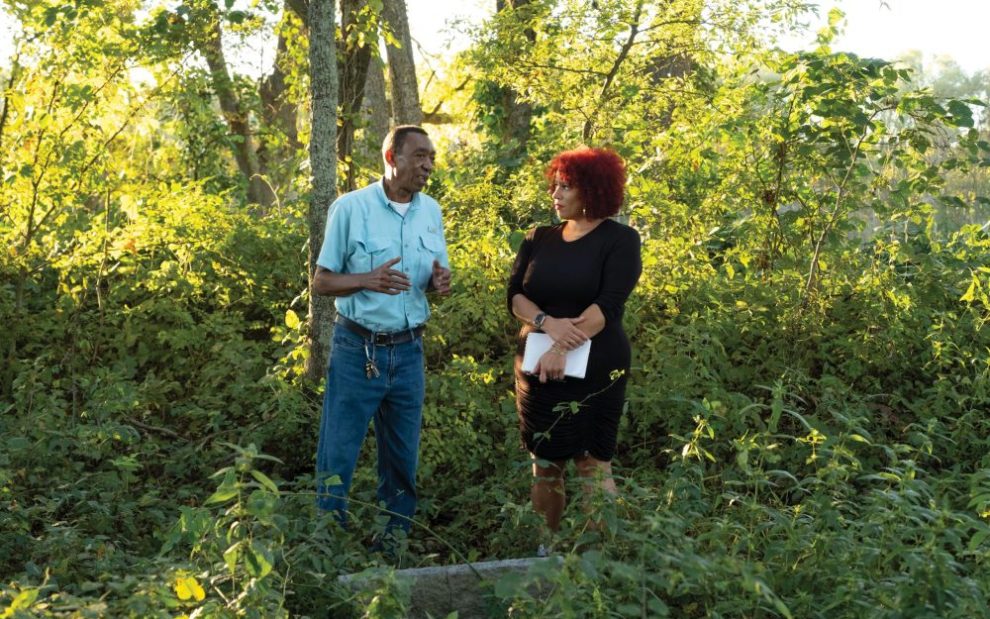In August 2019, the New York Times Magazine ran “The 1619 Project,” marking the 400th anniversary of the arrival of the first Africans in the British colonies of North America. Since that first publication, The 1619 Project has become a book and a school curriculum, and, inevitably, a lightning rod for culture war agitation over the teaching of history in American schools.
Now The 1619 Project is also a six-part documentary series streaming on Hulu. Each episode starts from one of the New York Times essays but expands and updates it with stories that put a living face on the history. The editor and lead writer of the Times’ project, Nikole Hannah-Jones, is on camera throughout and makes her own family’s experience a narrative through-line of sorts.
Hannah-Jones’ father was born near Greenwood, Mississippi, and in the first episode she visits that town for the first time. She sits with an older man named MacArthur Cotton for an interview in front of the very courthouse where he and other local Black residents were once brutalized for attempting to register to vote. Later, in the “Capitalism” episode, Hannah-Jones uses her own cousin’s lifelong struggle with low-wage jobs to illustrate the burden Black people bear in the U.S. economy. In that episode, we also meet Derrick Palmer, a worthy young successor to MacArthur Cotton. Palmer is a Black Amazon worker who took part in the successful drive for a union at one of the company’s New York warehouses. The last episode, “Justice,” is mostly about the case for economic reparations but also tells the story of a long-standing, self-reliant Black community in Harris Neck, Georgia that lost its land to the U.S. government during World War II and is still fighting to get it back.
The thesis of The 1619 Project, in all its various incarnations, is that slavery and the invention of white supremacy to justify it are central facts of American history. That is something every American needs to know and many want to forget. Also, much of the vilification of The 1619 Project on the political right is the same old dog whistle appeal to racism that we’ve heard for decades. However, some of The 1619 Project’s more responsible critics do have their points.
For example, in the original print newspaper edition, Hannah-Jones wrote that “one of the primary reasons the colonists decided to declare their independence from Britain was because they wanted to protect the institution of slavery.” Several eminent U.S. historians objected, and the Times’ editors eventually had to revise the online version of that sentence to say “some of the colonists.”
A more significant concern raised about The 1619 Project is its claim, repeated in the first episode of the Hulu series, that 1619 was “the beginning of American slavery.” As the distinguished African American historian Nell Irvin Painter pointed out in the Guardian, “People were not enslaved in Virginia in 1619, they were indentured.” “Enslavement,” Painter adds, “was a process that took place step-by-step, after the mid-17th century.”
Here, The 1619 Project would do well to consult with one of its counterparts in the school curriculum world, Facing History and Ourselves, which began as a Holocaust education project. In the Facing History lesson called “Inventing Black and White,” students learn about an African man in early 1600s Virginia who completed a term of indenture and became a well-respected landowner; they also learn about an African woman “wrongfully enslaved” who sued for freedom in the Virginia courts and won. As the title suggests, “Inventing Black and White” maintains that in colonial Virginia “racial” distinctions evolved to justify what planters came to see as the economic necessity of permanently enslaved labor.
According to Facing History, a major turning point in this process was Bacon’s Rebellion in 1676. This uprising began among Virginia farmers but was soon joined by hundreds of slaves and servants, Black and white, demanding land and freedom. The army of Bacon’s Rebellion eventually captured the colonial capital of Jamestown and burned it to the ground.
As Michelle Alexander put it in her book The New Jim Crow (quoted in “Inventing Black and White”): “The events in Jamestown were alarming to the planter elite, who were deeply fearful of the multiracial alliance of [indentured servants] and slaves.” That fear deepened when “several more uprisings of a similar type followed.” Finally, Alexander says, “to protect their superior status and economic position, the planters shifted their strategy . . . They abandoned their heavy reliance on indentured servants in favor of the importation of more Black slaves.”
That is when race started to dominate life in the Virginia colony. Laws were passed establishing life-long slavery, inherited from mother to child, for people of African descent, along with measures to improve the status of the colony’s poor whites.
Hannah-Jones writes that white supremacy “runs in the very DNA of this country.” Facing History, on the other hand, declares in its mission statement “that history is not inevitable: People make choices and choices make history.” The distinction matters. DNA can’t be changed, but choices can be reversed.
The Bacon’s Rebellion story suggests that the ideology of white supremacy came about in large part to divide the working class for the benefit of the elite. One could argue that it does the same thing today. The 1619 Project, for all the good that it is doing, may also help obscure that essential fact of U.S. history and American life.
This article also appears in the June 2023 issue of U.S. Catholic (Vol. 88, No. 6, pages 36-37). Click here to subscribe to the magazine.
Image: Hulu/Patti Perret












Add comment